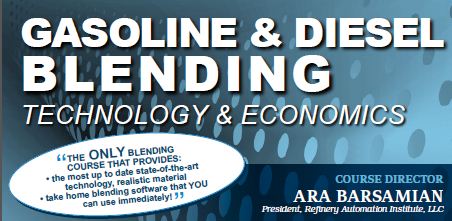RL Blogs

By Conference Connection
Jun 01, 2014This three-day course is designed to provide a comprehensive overview and discussion of gasoline and diesel blending techniques, technology and cost/benefits. |
| Gasoline & Diesel Blending Technology and Economics (GDB) * 12 - 14 November 2014, Singapore
About the Course These are the best dollars you’ll ever spend on a practical, hands-on course with take-home blending software. Ara’s course synthesizes 40 years of blending experience working with Exxon and other multinationals in developing and using cutting edge fuels blending techniques around the world.
How do you maximize fuel blending profits? What blendstocks should buy? How do you minimize quality giveaways? What is the Ethanol octane boost? Is second generation biodiesel “better” than the first? How do you avoid re-blends? What’s the best way to “fix” an off-spec? How do you justify blending facility upgrades? What are blending “Key Performance Indicators”?
Gasoline and diesel fuels comprise about 90% of the refinery fuel output, while independent traders buy and sell around 80 million barrels a day of fuels; that’s a lot of money. To be profitable, you need to get it done right the first time, meaning the cheapest and fastest way while meeting all the specs, environmental rules and regulations and renewables mandates.
You get answers in these courses designed for traders, blending engineers, senior operators, product coordinators, refinery planners, refinery lab personnel, and fuels marketers.
The course provides a comprehensive overview and discussion of:
Case studies are used to illustrate the relative importance of each aspect of the fuels blending operation, together with specific exercises. Attendees also receive free blending software and blend component data base that could be used when returning home. Participants should bring a laptop with Microsoft Excel 2007 or later, and Solver add-in installed, to the course.
The course will also be enhanced by a laboratory visit to witness fuel tests, such as octane, density, viscosity, and compatibility of fuels, and see the typical equipment used, such as octane and cetane engines, sulfur analyzers, gas chromatographs, and viscometers.
Who is the Course Director? Ara Barsamian, formerly of Exxon and ABB, is President of Refinery Automation Institute, LLC (RAIL), a fuels blending consulting company in Morristown, New Jersey, USA. Ara, the developer of the blending course, is one of the world's leading experts in blending operations and technology. He has over 40 years of hands-on experience in the petroleum refining industry, particularly in state-of-the-art computer-controlled blending, oil movements and tank farm automation.
He designed, implemented, started up and commissioned over 60 blending and oil movement systems in the U.S., Europe, South America, the Middle East and Asia. Previously, he was a group head and section head with Exxon Research and Engineering Company, President of 3X Corporation, and Vice President of ABB Simcon, all in the area of blending. He is an active member of ASTM, AIChE, ISA, ILTA, and IBIA, participating in committee/subcommittee work relevant to blending and offsites automation equipment, software, and installation and measurements standards and practices. Ara holds B.S. and M.S. degrees in Electrical Engineering from City University of New York. |
|
|









